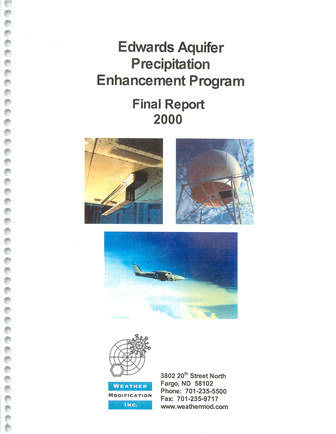Edwards Aquifer Precipitation Enhancement Program Final Report 2000

| Summary |
|
This report summarizes the activities and data collected during the 2000 field operations of the Edwards Aquifer Precipitation Enhancement Program. This was the second year of a program conducted by Weather Modification Inc. {WMI) of Fargo, North Dakota, for the Edwards Aquifer Authority (the Authority) of San Antonio, Texas. The program was funded by the Texas Natural Resource Conservation Commission and the Authority, with the sole intent being enhancement of precipitation through cloud seeding. The project area was 6.37 million acres across south Texas, covering all or parts of 12 counties including Real, Uvalde, Kerr, Bandera, Medina, Kendall, Bexar, Blanco, Comal, Hays, Guadalupe, and Caldwell. Seeding operations were conducted 24 hours-a-day, seven days-a-week from March 1st through November 30th. The facilities and procedures for this project were as follows. One C-band weather radar, computers, and a communications system were set up in Hondo, Texas, to monitor storms and control aircraft. The radar operated continuously throughout the nine-month period. The storms, as detected by radar, were posted on the WMIIntemet Home Page at 3D-minute intervals, thus allowing remote near real-time viewing of operations. Two specially equipped cloud seeding aircraft were dedicated to the project; both were stationed at the centrally located Hondo Regional Airport in Hondo, Texas. This maximized coverage of the target area and minimized response times. New and improved formulations of silver-iodide pyrotechnics and acetone solutions were used to generate high concentrations of very fast acting ice-nuclei. High performance aircraft crewed by experienced pilots and directed by experienced radar meteorologists treated developing regions of the storms by direct injection of the seeding agents. The 2000 field program successfully achieved its objective, to seed those cells thought to have the potential to produce precipitation. During the nine-month project, the two aircraft safely completed 82 flights totaling 218.80 hours. A total of 29.3 kg of seeding agent was dispensed in the form of 1,144 ejectable flares and 1 06 gallons of silver iodide – acetone solution, which was burned in wing-tip generators. This final report for 2000 provides a general overview of the program and describes the methodology used. Pictures, tables, graphs, and references are used to summarize the operational activities. All of the project’s radar data, meteorological data, and reports (weekly operations summaries and monthly reports) have been recorded onto CD-ROM and are available to the Authority. |
Search for Documents
Advance Search
Explore EAA's Scientific Reports
- All Reports
- Surface Water / Groundwater Relationship
- Biology
- Springs, Groundwater Discharge
- Archaeology
- RZ Protection
- Aquifer Levels
- Remote Sensing
- Precipitation
- Overview Studies
- Modeling
- Hydrology and Hydrogeology
- History
- Groundwater Recharge, Recharge Zone
- Groundwater Movement
- Geomorphology and Caves
- Weather Modification
- Geology
- Water Use and Conservation
- Geochemistry
- Water Resources Planning and Management
- Floods and Drought
- Water Quality
- Climatology
